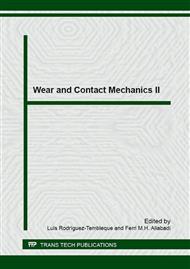[1]
F. Medina Reguera, H. Cifuentes Bulté, and F. Medina Encina, Modelling of the behavior of post-tensioned concrete structures subjected to long term thermal loads, in: 3rd Int. Conf. Mech. Models in Str. Eng. (2015) 385–402.
DOI: 10.4028/www.scientific.net/kem.681.197
Google Scholar
[2]
Grouting of tendons in prestressed concrete, International Federation for Structural Concrete, Bulletin 20, Sprint-Druck, Stuttgart, (2002).
Google Scholar
[3]
J. Khalaf, Z. Huang, M. Fan, Analysis of bond-slip between concrete and steel bar in fire, Comput. Struct. 16 (2016) 1–15.
DOI: 10.1016/j.compstruc.2015.09.011
Google Scholar
[4]
M. Heristchian, P. Pourakbar, S. Imeni, M. R. A. Ramezani, Ultimate tensile strength of embedded I-sections: a comparison of experimental and numerical results, Int. J. Adv. Struct. Eng., 6 (2014) 169–180.
DOI: 10.1007/s40091-014-0077-y
Google Scholar
[5]
J. Melo, C. Fernandes, H. Varum, H. Rodrigues, A. Costa, A. Arêde, Numerical modelling of the cyclic behaviour of RC elements built with plain reinforcing bars, Eng. Struct. 33 (2011) 273–286.
DOI: 10.1016/j.engstruct.2010.11.005
Google Scholar
[6]
G. M. Verderame, P. Ricci, G. De Carlo, G. Manfredi, Cyclic bond behaviour of plain bars. Part I: Experimental investigation, Constr. Build. Mater. 23 (2009) 3499–3511.
DOI: 10.1016/j.conbuildmat.2009.07.002
Google Scholar
[7]
D. D. S. Brisotto, E. Bittencourt, V. M. R. D. a Bessa, Simulating bond failure in reinforced concrete by a plasticity model, Comput. Struct. 106–107 (2012) 81–90.
DOI: 10.1016/j.compstruc.2012.04.009
Google Scholar
[8]
Bond of Reinforcement in Concrete, International Federation for Structural Concrete, Bulletin 10, Sprint -Druck, Stuttgart, (2000).
Google Scholar
[9]
F. Xu, Z. M. Wu, J. J. Zheng, Y. Hu, Q. Bin Li, Bond behavior of plain round bars in concrete under complex lateral pressures, ACI Struct. J. 111 (2014) 15–25.
DOI: 10.14359/51686427
Google Scholar
[10]
Model code 2010, 1, International Federation for Structural Concrete, DCC Document Competence Center Siegmar Kästl e.K., Germany, (2012).
Google Scholar
[11]
V. Cervenka, R. Eligehausen, Simulation of Cracking and Failure of Concrete Structures, Femcad, Struceng & Optimization, (1990) 323-328.
Google Scholar
[12]
W. C. Stone and J. E. Breen, Design of post-tensioned girder anchorage zones, FHWA, National Technical Information Service, Virginia, (1981).
Google Scholar
[13]
W. C. Stone and J. E. Breen, Behavior of Post-Tensioned Girder Anchorage Zones, PCI J., January-February (1984).
DOI: 10.15554/pcij.01011984.64.109
Google Scholar
[14]
AASHTO LRFD Bridge Design Specifications, American Association of State Highway and Transportation Officials, 5th Ed., AASHTO, Washington, (2010).
Google Scholar
[15]
J. Lubliner, J. Oliver, S. Oller, and E. Oñate, A plastic-damage model for concrete, Int. J. Solids Struct. 25 (1989) 299–326.
DOI: 10.1016/0020-7683(89)90050-4
Google Scholar
[16]
Abaqus Theory Guide 6. 14, Dassault Systèmes, (2014).
Google Scholar
[17]
Z. P. Bažant, Analysis of Work-of-Fracture Method for Measuring Fracture Energy of Concrete, J. Eng. Mat. 122 (1996) 138–144.
DOI: 10.1061/(asce)0733-9399(1996)122:2(138)
Google Scholar
[18]
H. Cifuentes Bulté, F. Medina Encina, Mecánica de la fractura aplicada al hormigón, Universidad de Sevilla, Sevilla, (2014).
Google Scholar
[19]
T. Jankowiak, T. Lodygowski, Identification of parameters of concrete damage plasticity constitutive model, Found. Civ. Environ. Eng. 6 (2005) 53–69.
Google Scholar
[20]
W. B. Krätzig, R. Pölling, An elasto-plastic damage model for reinforced concrete with minimum number of material parameters, Comput. Struct. 82 (2004) 1201–1215.
DOI: 10.1016/j.compstruc.2004.03.002
Google Scholar
[21]
A. Carpinteri, M. Corrado, M. Paggi, An Analytical Model Based on Strain Localisation for the Study of Size-Scale and Slenderness Effects in Uniaxial Compression Tests, Strain 47 (2011) 351–362.
DOI: 10.1111/j.1475-1305.2009.00715.x
Google Scholar
[22]
V. Birtel, P. Mark, Parameterised Finite Element Modelling of RC Beam Shear Failure, in: 2006 ABAQUS Users' Conference (2006) 95–108.
Google Scholar
[23]
P. F. Pallett, N. J. Gorst, L. A. Clark, W. S. J, Friction in Temporary Works, Health and Safety Executive Books, Crown, Birmingham, (2003).
Google Scholar
[24]
B. G. Rabbat, H. G. Russell, Friction Coefficient of Steel on Concrete or Grout, J. Struct. Eng. 111 (1985) 505–515.
DOI: 10.1061/(asce)0733-9445(1985)111:3(505)
Google Scholar
[25]
Practitioners Guide to Finite Element Modelling of Reinforced Concrete Structures, International Federation for Structural Concrete, Bulletin 45, Sprint-Digital-Druck, Stuttgart, (2008).
Google Scholar
[26]
E. Ellobody, C. G. Bailey, Modelling of unbonded post-tensioned concrete slabs under fire conditions, Fire Saf. J., 44 (2009) 159–167.
DOI: 10.1016/j.firesaf.2008.05.007
Google Scholar
[27]
E. Ellobody, C. G. Bailey, Structural performance of a post-tensioned concrete floor during horizontally travelling fires, Eng. Struct. 33 (2011) 1908–(1917).
DOI: 10.1016/j.engstruct.2011.02.024
Google Scholar


